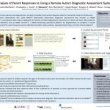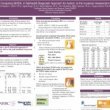The Critical Need For Telehealth Research
 There is a pressing need for diagnostic and intervention services to support the rapidly growing population of children with Autism Spectrum Disorders (Autism and Developmental Disabilities Monitoring (ADDM) Network, 2009). Direct observation of the child remains the gold standard practice in diagnosis, assessment, and treatment planning for children with autism and related developmental disabilities (Filipek, Accardo, Barnek, Cook, Dawson, Gordon, et al.,1999; National Research Council, 2001; Ozonoff, Goodlin-Jones & Solomon, 2005). Moreover, the literature supports early screening to ensure that children are referred for diagnostic assessments sooner, and that timely evaluations of eligibility for services result in immediate implementation of appropriate early intervention (American Academy of Pediatrics Council on Children With Disabilities, 2007; Johnson, Myers).
There is a pressing need for diagnostic and intervention services to support the rapidly growing population of children with Autism Spectrum Disorders (Autism and Developmental Disabilities Monitoring (ADDM) Network, 2009). Direct observation of the child remains the gold standard practice in diagnosis, assessment, and treatment planning for children with autism and related developmental disabilities (Filipek, Accardo, Barnek, Cook, Dawson, Gordon, et al.,1999; National Research Council, 2001; Ozonoff, Goodlin-Jones & Solomon, 2005). Moreover, the literature supports early screening to ensure that children are referred for diagnostic assessments sooner, and that timely evaluations of eligibility for services result in immediate implementation of appropriate early intervention (American Academy of Pediatrics Council on Children With Disabilities, 2007; Johnson, Myers).
Despite this literature, many rural communities that are also characterized by low socio-economic status (SES) are marked by lack of access to autism-specific expertise among professionals in mental health, primary care, and education (Belfer & Saxena, 2006; Marcin, Ellis, Mawis, et al., 2004; Nesbitt, Rogers, Rich, et al., 2006). Even in urban communities where services are more widely available, timely access to diagnostic and intervention services is often hampered by long waiting lists at centers focused on diagnosis and treatment (Hayden, 2011).
Telehealth Practices Promising and in Need of More Research
Despite g rowing recognition of the potential for telehealth to improve access to care for individuals with ASDs (Karp, Grigsby, McSwiggan-Hardin, Pursley-Crotteau, Adams, Bell, W., et al., 2000; Saint-André, Zalentein, Robin, & Lazartigues, 2011; Terry, 2009; Baharav & Reiser, 2010), few peer-reviewed evaluations of telehealth technologies applied to autism have been published (Boisvert, Lang, Andrianopoulus & Boscardin, 2010). Boisvert and colleagues (2010) found that 7 of the 8 studies reviewed reported successful implementation and positive outcomes of services delivered via telepractice. However, the total number of participants across these studies was extremely small (n=46), most lacked a true experimental design, and only a single study directly compared the effectiveness of services delivered via telepractice to the same services delivered in person.
rowing recognition of the potential for telehealth to improve access to care for individuals with ASDs (Karp, Grigsby, McSwiggan-Hardin, Pursley-Crotteau, Adams, Bell, W., et al., 2000; Saint-André, Zalentein, Robin, & Lazartigues, 2011; Terry, 2009; Baharav & Reiser, 2010), few peer-reviewed evaluations of telehealth technologies applied to autism have been published (Boisvert, Lang, Andrianopoulus & Boscardin, 2010). Boisvert and colleagues (2010) found that 7 of the 8 studies reviewed reported successful implementation and positive outcomes of services delivered via telepractice. However, the total number of participants across these studies was extremely small (n=46), most lacked a true experimental design, and only a single study directly compared the effectiveness of services delivered via telepractice to the same services delivered in person.
The authors concluded that telepractice is a promising service delivery approach for individuals with ASD that warrants additional research, particularly with respect to technological requirements to support diagnostic protocols and intervention procedures, analysis of clinical efficacy and effectiveness, and cost-benefit analyses. Based on these identified areas of need, our system for approaching both diagnostic assessment and treatment planning will address these shortcomings and the effectiveness and efficacy of the system will be tested in two separate clinical settings using rigorous scientific methods.
Shortening Wait Lists, Providing Care to Remote Areas
 Asynchronous (store-and-forward) telehealth technology, such as our own Behavior Imaging technology, demonstrates how contextual video capture and a complementary online consultation platform effectively address the need for observation of the child by a professional who can make more timely clinical decisions regarding diagnosis and treatment. Beyond the potential for such technology to improve access to care for remotely located children (i.e., rural areas, military bases, etc.), it can also enable clinical centers around the country to shorten their wait-lists by facilitating more timely communication with families about the nature and range of the child’s symptoms and needs. There is great potential for enabling these centers to quickly gather initial clinical impressions of the child by reviewing videos collected by caregivers in the home, and then to more effectively triage cases into those that are clear cut and those that require more extensive in-person assessment.
Asynchronous (store-and-forward) telehealth technology, such as our own Behavior Imaging technology, demonstrates how contextual video capture and a complementary online consultation platform effectively address the need for observation of the child by a professional who can make more timely clinical decisions regarding diagnosis and treatment. Beyond the potential for such technology to improve access to care for remotely located children (i.e., rural areas, military bases, etc.), it can also enable clinical centers around the country to shorten their wait-lists by facilitating more timely communication with families about the nature and range of the child’s symptoms and needs. There is great potential for enabling these centers to quickly gather initial clinical impressions of the child by reviewing videos collected by caregivers in the home, and then to more effectively triage cases into those that are clear cut and those that require more extensive in-person assessment.
In addition, the system allows for multiple raters to view evidence thus providing a format for documenting inter-rater reliability. In cases where raters are not in full agreement as to a specific diagnosis or plan for treatment, this system also allows for a third rater to view the evidence and weigh in on the decision. This capability further allows clinicians and educational professionals to make more informed decisions based on visual evidence.
Capturing Behavior in a Natural Setting for More Efficient and Accurate Assessments
Behavior Imaging technology facilitates clinical decisions based on child behaviors captured as they occur in natural settings. In contrast, the current practice of observing the child in a specialized room at a clinic may produce reactivity effects in the child, both those introduced by a novel environment and unfamiliar observer (Gardner, 2000; Kazdin, 1982). Moreover, for many interventions like those targeting challenging behaviors, a key component of treatment planning involves understanding the function of the behavior. However, the stimuli that evoke the behavior as well as consequences that maintain it in the natural environment may not be observed in an artificial setting like a clinic.
 Thus, Behavior Imaging technology allows for families and caregivers to capture not only the behavior, but what happened right before it (i.e., antecedent) and what happened right after (i.e., consequence). With this knowledge, practitioners are able to further understand potential triggers for problem behaviors and actions that may be maintaining its occurrence. Results of a multi-site (Oberleitner et al., 2007) user study identified a need for this technology in the process of behavior assessment, supporting teaching practices, increasing administrative support, and the ability to gain input from experts in the field.
Thus, Behavior Imaging technology allows for families and caregivers to capture not only the behavior, but what happened right before it (i.e., antecedent) and what happened right after (i.e., consequence). With this knowledge, practitioners are able to further understand potential triggers for problem behaviors and actions that may be maintaining its occurrence. Results of a multi-site (Oberleitner et al., 2007) user study identified a need for this technology in the process of behavior assessment, supporting teaching practices, increasing administrative support, and the ability to gain input from experts in the field.
Enabling Collaboration between Families and Professionals
Behavior Imaging technology will further enable collaboration and consultation between families and professionals through a secure health record application that allows users to store, share, and annotate captured video. Our long-term vision is that this telehealth system will to a great extent replace current practices to provide patients with diagnoses and treatment plans based on information that is collected in natural environments, and is thus more ecologically valid. At the same time, our system will make more efficient use of professionals’ time and reduce office visit times for patients and their families. By providing a format for collecting and analyzing visual evidence, both diagnosis and treatment efforts will translate into a streamlined approach that is ultimately more reliable and cost effective for practitioners and families.










